Partitioning of Cotton Field Evapotranspiration under Mulched Drip Irrigation Based on a Dual Crop Coefficient Model
Abstract
:1. Introduction
2. Materials and Methods
2.1. Experimental Site
2.2. Cotton Planting
2.3. EC System
2.4. SIMDualKc Model
- (a)
- Soil data: the total available water (, mm·m−1). It can be calculated with the field soil content and wilting point soil moisture or use the suggested the values; amount and depth of the soil layers; effective depth of the evaporation layer (, m); readily and total evaporable water ( and , mm); and textural classes of that layer when the values are calculated by the model.
- (b)
- Meteorological daily data: minimum and maximum air temperature, and (°C); reference evapotranspiration (, mm); minimum relative humility (, %); precipitation (, mm); and wind speed at 2 m height (, ms−1).
- (c)
- Crop data: data for the initial, crop development, mid-season, late-season and harvest or end-of-season growth stages; initial and end-of-season data of frozen soil; basal crop coefficient () for the initial, mid-season and harvest growth stages; soil water depletion fraction without stress (), and the fraction of ground cover (), for all growth stages; root depths (, m) and crop height (, m).
- (d)
- Irrigation data: irrigation system; irrigation data; fraction of soil surface wetted by irrigation () and the depth of each irrigation.
- (e)
- Other data: data used for the capillary rise and deep percolation equations; mulch data, including related management; active ground cover characteristics; and runoff data.
2.5. Model Calibration and Validation
- (a)
- The Nash–Sutcliffe model efficiency coefficient , which is the ratio of the mean square error to the variance in the observed data [27]:
- (b)
- The root mean square error, which characterizes the variance of the errors:
- (c)
- The ratio RSR of the RMSE to the standard deviation of observed data (sd) that standardizes RMSE using the sd of observations:
- (d)
- The average absolute error, which expresses the magnitude of estimation errors in alternative to :
- (e)
- The average relative error, which indicates the size of errors in relative terms and is expressed as a percentage:
- (f)
- The percent bias, which indicates measures the average tendency of the simulated data to be larger or smaller than their corresponding observations:
3. Results and Discussion
3.1. Model Calibration and Validation
3.2. Crop Coefficients
3.3. Partitioning of Evapotranspiration
3.4. Influence of Plastic Mulch
4. Conclusions
Acknowledgments
Author Contributions
Conflicts of Interest
References
- Li, S.; Kang, S.; Li, F.; Zhang, L. Evapotranspiration and crop coefficient of spring maize with plastic mulch using eddy covariance in northwest China. Agric. Water Manag. 2008, 95, 1214–1222. [Google Scholar] [CrossRef]
- Burt, C.M.; Mutziger, A.J.; Allen, R.G.; Howell, T.A. Evaporation research: Review and interpretation. J. Irrig. Drain. 2005, 131, 37–58. [Google Scholar] [CrossRef]
- Hu, X.; Chen, H.; Wang, J.; Meng, X.; Chen, F. Effects of Soil Water Content on Cotton Root Growth and Distribution under Mulched Drip Irrigation. Agric. Sci. China 2009, 8, 709–716. [Google Scholar] [CrossRef]
- Kool, D.; Agam, N.; Lazarovitch, N.; Heitman, J.L.; Sauer, T.J.; Ben-Gal, A. A review of approaches for evapotranspiration partitioning. Agric. For. Meteorol. 2014, 184, 56–70. [Google Scholar] [CrossRef]
- Benli, B.; Kodal, S.; Ilbeyi, A.; Ustun, H. Determination of evapotranspiration and basal crop coefficient of alfalfa with a weighing lysimeter. Agric. Water Manag. 2006, 81, 358–370. [Google Scholar] [CrossRef]
- López-Urrea, R.; de Santa-Olalla, F.M.; Montoro, A.; López-Fuster, P. Single and dual crop coefficients and water requirements for onion (Allium cepa L.) under semiarid conditions. Agric. Water Manag. 2009, 96, 1031–1036. [Google Scholar] [CrossRef]
- Wilson, K.B.; Hanson, P.J.; Mulholland, P.J.; Baldocchi, D.D.; Wullschleger, S.D. A comparison of methods for determining forest evapotranspiration and its components: Sap-flow, soil water budget, eddy covariance and catchment water balance. Agric. For. Meteorol. 2011, 106, 153–168. [Google Scholar] [CrossRef]
- Poblete-Echeverría, C.; Ortega-Farias, S.; Zuñiga, M. Estimation of Dual Crop Coefficients over a Drip-Irrigated Merlot Vineyard Using Sap Flow Sensors and Eddy Covariance System. ISHS Acta Hortic. VIII Int. Symp. Sap Flow 2011, 951, 269–275. [Google Scholar] [CrossRef]
- Zhang, Y.; Shen, Y.; Sun, H.; Gates, J.B. Evapotranspiration and its partitioning in an irrigated winter wheat field: A combined isotopic and micrometeorologic approach. J. Hydrol. 2011, 408, 203–211. [Google Scholar] [CrossRef]
- Yepez, E.A.; Williams, D.G.; Scott, R.L.; Lin, G. Partitioning overstory and understory evapotranspiration in a semiarid savanna woodland from the isotopic composition of water vapor. Agric. For. Meteorol. 2003, 119, 53–68. [Google Scholar] [CrossRef]
- Zhang, F.; Zhou, G.; Wang, Y.; Yang, F.; Nilsson, C. Evapotranspiration and crop coefficient for a temperate desert steppe ecosystem using eddy covariance in Inner Mongolia, China. Hydrol. Process. 2012, 26, 379–386. [Google Scholar] [CrossRef]
- Allen, R.G.; Pereira, L.S.; Raes, D.; Smith, M. Crop Evapotranspiration-Guidelines for Computing Crop Water Requirements—FAO Irrigation and Drainage Paper 56; Food and Agriculture Organization of the United Nations: Rome, Italy, 1998. [Google Scholar]
- Monteith, J.L.; Unsworth, M.H. Principles of Environmental Physics; Academic Press: New York, NY, USA, 2008. [Google Scholar]
- Utset, A.; Farre, I.; Martinez-Cob, A.; Cavero, J. Comparing Penman–Monteith and Priestley–Taylor approaches as reference-evapotranspiration inputs for modeling maize water-use under Mediterranean conditions. Agric. Water Manag. 2004, 66, 205–219. [Google Scholar] [CrossRef]
- Amayreh, J.; Al-Abed, N. Developing crop coefficients for field-grown tomato (Lycopersicon esculentum Mill.) under drip irrigation with black plastic mulch. Agric. Water Manag. 2005, 73, 247–254. [Google Scholar] [CrossRef]
- Bezerra, B.G.; da Silva, B.B.; Bezerra, J.R.C.; Sofiatti, V.; dos Santos, C.A.C. Evapotranspiration and crop coefficient for sprinkler-irrigated cotton crop in Apodi Plateau semiarid lands of Brazil. Agric. Water Manag. 2012, 107, 86–93. [Google Scholar] [CrossRef]
- Han, S.; Xu, D.; Wang, S.; Yang, Z. Water requirement with irrigation expansion in Jingtai Irrigation District, Northwest China: The need to consider irrigation-induced local changes in evapotranspiration demand. J. Irrig. Drain. Eng. 2014, 140. [Google Scholar] [CrossRef]
- Allen, R.G. Using the FAO-56 dual crop coefficient method over an irrigated region as part of an evapotranspiration intercomparison study. J. Hydrol. 2000, 229, 27–41. [Google Scholar] [CrossRef]
- Cancela, J.J.; Fandiño, M.; Rey, B.J.; Martínez, E.M. Automatic irrigation system based on dual crop coefficient, soil and plant water status for Vitis vinifera (cv Godello and cv Mencía). Agric. Water Manag. 2015, 151, 52–63. [Google Scholar] [CrossRef]
- Ding, R.; Kang, S.; Zhang, Y.; Hao, X.; Tong, L.; Du, T. Partitioning evapotranspiration into soil evaporation and transpiration using a modified dual crop coefficient model in irrigated maize field with ground-mulching. Agric. Water Manag. 2013, 127, 85–96. [Google Scholar] [CrossRef]
- Paço, T.A.; Pôças, I.; Cunha, M.; Silvestre, J.C.; Santos, F.L.; Paredes, P.; Pereira, L.S. Evapotranspiration and crop coefficients for a super intensive olive orchard. An application of SIMDualKc and METRIC models using ground and satellite observations. J. Hydrol. 2014, 519, 2067–2080. [Google Scholar] [CrossRef]
- Zhang, B.; Liu, Y.; Xu, D.; Zhao, N.; Lei, B.; Rosa, R.D.; Paredes, P.; Paço, T.A.; Pereira, L.S. The dual crop coefficient approach to estimate and partitioning evapotranspiration of the winter wheat-summer maize crop sequence in North China Plain. Irrig. Sci. 2013, 31, 1303–1316. [Google Scholar] [CrossRef]
- Zhao, N.; Liu, Y.; Cai, J.; Paredes, P.; Rosa, R.D.; Pereira, L.S. Dual crop coefficient modelling applied to the winter wheat-summer maize crop sequence in North China Plain: Basal crop coefficients and soil evaporation component. Agric. Water Manag. 2013, 117, 93–105. [Google Scholar] [CrossRef]
- Rosa, R.D.; Paredes, P.; Rodrigues, G.C.; Alves, I.; Fernando, R.M.; Pereira, L.S.; Allen, R.G. Implementing the dual crop coefficient approach in interactive software. 1. Background and computational strategy. Agric. Water Manag. 2012, 103, 8–24. [Google Scholar] [CrossRef]
- Fandiño, M.; Olmedo, J.L.; Martínez, E.M.; Valladares, J.; Paredes, P.; Rey, B.J.; Mota, M.; Cancela, J.J.; Pereira, L.S. Assessing and modelling water use and the partition of evapotranspiration of irrigated hop (Humulus lupulus), and relations of transpiration with hops yield and alpha-acids. Ind. Crop. Prod. 2015, 77, 204–217. [Google Scholar] [CrossRef]
- Martins, J.D.; Rodrigues, G.C.; Paredes, P.; Carlesso, R.; Oliveira, Z.B.; Knies, A.E.; Petry, M.T.; Pereira, L.S. Dual crop coefficients for maize in southern Brazil: Model testing for sprinkler and drip irrigation and mulched soil. Biosyst. Eng. 2013, 115, 291–310. [Google Scholar] [CrossRef]
- Nash, J.; Sutcliffe, J.V. River flow forecasting through conceptual models part I—A discussion of principles. J. Hydrol. 1970, 10, 282–290. [Google Scholar] [CrossRef]
- Paço, T.A.; Ferreira, M.I.; Rosa, R.D.; Paredes, P.; Rodrigues, G.C.; Conceição, N.; Pacheco, C.A.; Pereira, L.S. The dual crop coefficient approach using a density factor to simulate the evapotranspiration of a peach orchard: SIMDualKc model versus eddy covariance measurements. Irrig. Sci. 2012, 30, 115–126. [Google Scholar] [CrossRef]
- Pereira, L.S.; Paredes, P.; Rodrigues, G.C.; Neves, M. Modeling malt barley water use and evapotranspiration partitioning in two contrasting rainfall years. Assessing AquaCrop and SIMDualKc models. Agric. Water Manag. 2015, 159, 239–254. [Google Scholar] [CrossRef]
- Wu, Y.; Liu, T.; Paredes, P.; Duan, L.; Wang, H.; Wang, T.; Pereira, L.S. Ecohydrology of groundwater-dependent grasslands of the semi-arid Horqin sandy land of inner Mongolia focusing on evapotranspiration partition. Ecohydrology 2015. [Google Scholar] [CrossRef]
- Wei, Z.; Paredes, P.; Liu, Y.; Chi, W.W.; Pereira, L.S. Modelling transpiration, soil evaporation and yield prediction of soybean in North China Plain. Agric. Water Manag. 2015, 147, 43–53. [Google Scholar] [CrossRef]
- Allen, R.G.; Pereira, L.S. Estimating crop coefficients from fraction of ground cover and height. Irrig. Sci. 2009, 28, 17–34. [Google Scholar] [CrossRef]
- Fandiño, M.; Cancela, J.J.; Rey, B.J.; Martínez, E.M.; Rosa, R.G.; Pereira, L.S. Using the dual-K c approach to model evapotranspiration of Albarino vineyards (Vitisvinifera L. cv. Albarino) with consideration of active ground cover. Agric. Water Manag. 2012, 112, 75–87. [Google Scholar] [CrossRef]
- Liu, Y.; Pereira, L.S.; Fernando, R.M. Fluxes through the bottom boundary of the root zone in silty soils: Parametric approaches to estimate groundwater contribution and percolation. Agric. Water Manag. 2006, 84, 27–40. [Google Scholar] [CrossRef]
- Rosa, R.D.; Paredes, P.; Rodrigues, G.C.; Fernando, R.M.; Alves, I.; Pereira, L.S.; Allen, R.G. Implementing the dual crop coefficient approach in interactive software: 2. Model testing. Agric. Water Manag. 2012, 103, 62–77. [Google Scholar] [CrossRef]
- Yaghi, T.; Arslan, A.; Naoum, F. Cucumber (Cucumis sativus, L.) water use efficiency (WUE) under plastic mulch and drip irrigation. Agric. Water Manag. 2013, 128, 149–157. [Google Scholar] [CrossRef]
- Yu, G.-R.; Wen, X.-F.; Sun, X.-M.; Tanner, B.D.; Lee, X.; Chen, J.-Y. Overview of ChinaFLUX and evaluation of its eddy covariance measurement. Agric. For. Meteorol. 2006, 137, 125–137. [Google Scholar] [CrossRef]
- Zhang, Z.; Tian, F.; Hu, H.; Yang, P. A comparison of methods for determining field evapotranspiration: Photosynthesis system, sap flow, and eddy covariance. Hydrol. Earth Syst. Sci. 2014, 18, 1053–1072. [Google Scholar] [CrossRef]
- Er-Raki, S.; Chehbouni, A.; Boulet, G.; Williams, D.G. Using the dual approach of FAO-56 for partitioning ET into soil and plant components for olive orchards in a semi-arid region. Agric. Water Manag. 2010, 97, 1769–1778. [Google Scholar] [CrossRef] [Green Version]
- Facchi, A.; Gharsallah, O.; Corbari, C.; Masseroni, D.; Mancini, M.; Gandolfi, C. Determination of maize crop coefficients in humid climate regime using the eddy covariance technique. Agric. Water Manag. 2013, 130, 131–141. [Google Scholar] [CrossRef]
- Baffes, J. Cotton: Market Setting, Trade Policies, and Issues; World Bank: Washington, DC, USA, 2004. [Google Scholar]
- China National Cotton Information Center (CNCIC). China Cotton Almanac 2012/2013; China Financial & Economic Publishing House: Beijing, China, 2014. [Google Scholar]
- Han, S.; Hu, H.; Yang, D.; Liu, Q. Irrigation impact on annual water balance of the oases in Tarim Basin, Northwest China. Hydrol. Process. 2011, 25, 167–174. [Google Scholar] [CrossRef]
- Hu, H.; Tian, F.; Hu, H. Soil particle size distribution and its relationship with soil water and salt under mulched drip irrigation in Xinjiang of China. China Technol. Sci. 2011, 54, 1568–1574. [Google Scholar] [CrossRef]
- Shen, Y.; Li, S.; Chen, Y.; Qi, Y.; Zhang, S. Estimation of regional irrigation water requirement and water supply risk in the arid region of Northwestern China 1989–2010. Agric. Water Manag. 2013, 128, 55–64. [Google Scholar] [CrossRef]
- Chen, M.; Kang, Y.; Wan, S.; Liu, S. Drip irrigation with saline water for oleic sunflower (Helianthus annuus L.). Agric. Water Manag. 2009, 96, 1766–1772. [Google Scholar] [CrossRef]
- Chen, W.; Hou, Z.; Wu, L.; Liang, Y.; Wei, C. Evaluating salinity distribution in soil irrigated with saline water in arid regions of northwest China. Agric. Water Manag. 2010, 97, 2001–2008. [Google Scholar] [CrossRef]
- Wang, R.; Kang, Y.; Wan, S.; Hu, W.; Liu, S.; Liu, S. Salt distribution and the growth of cotton under different drip irrigation regimes in a saline area. Agric. Water Manag. 2011, 100, 58–69. [Google Scholar] [CrossRef]
- Shukla, S.; Shrestha, N.K.; Jaber, F.H.; Srivastava, S.; Obreza, T.A.; Boman, B.J. Evapotranspiration and crop coefficient for watermelon grown under plastic mulched conditions in sub-tropical Florida. Agric. Water Manag. 2014, 132, 1–9. [Google Scholar] [CrossRef]
- Zhang, Z.; Hu, H.; Tian, F.; Hu, H.; Yao, X.; Zhong, R. Soil salt distribution under mulched drip irrigation in an arid area of northwestern China. J. Arid Environ. 2014, 104, 23–33. [Google Scholar] [CrossRef]
- Forkutsa, I.; Sommer, R.; Shirokova, Y.I.; Lamers, J.P.A.; Kienzler, K.; Tischbein, B.; Martius, C.; Vlek, P.L.G. Modeling irrigated cotton with shallow groundwater in the Aral Sea Basin of Uzbekistan: II. Soil salinity dynamics. Irrig. Sci. 2009, 27, 319–330. [Google Scholar] [CrossRef]
- Qureshi, A.S.; Eshmuratov, D.; Bezborodov, G. Determining optimal groundwater table depth for maximizing cotton production in the Sardarya province of Uzbekistan. Irrig. Drain. 2011, 60, 241–252. [Google Scholar] [CrossRef]
- Shrestha, N.K.; Shukla, S. Basal crop coefficients for vine and erect crops with plastic mulch in a sub-tropical region. Agric. Water Manag. 2014, 143, 29–37. [Google Scholar] [CrossRef]
- Zhang, Z.; Hu, H.; Tian, F.; Yao, X.; Sivapalan, M. Groundwater Dynamics under Water Saving Irrigation and Implications for Sustainable Water Management in an Oasis: Tarim River Basin of Western China. Hydrol. Earth Syst. Sci. 2014, 18, 3951–3967. [Google Scholar] [CrossRef]
- Van Dijk, A.; Moene, A.F.; De Bruin, H. The Principles of Surface Flux Physics: Theory, Practice and Description of the ECPACK Library; University of Wageningen: Wageningen, The Netherlands, 2004. [Google Scholar]
- Zhou, S.; Wang, J.; Liu, J.; Yang, J.; Xu, Y.; Li, J. Evapotranspiration of a drip-irrigated, film-mulched cotton field in northern Xinjiang, China. Hydrol. Process. 2012, 26, 1169–1178. [Google Scholar] [CrossRef]
- Allen, R.G.; Pereira, L.S.; Smith, M.; Raes, D.; Wright, J.L. FAO-56 dual crop coefficient method for estimating evaporation from soil and application extensions. J. Irrig. Drain. 2005, 131, 2–13. [Google Scholar] [CrossRef]
- Doorenbos, J.; Pruitt, W.O. Crop Water Requirements. Irrigation and Drainage Paper No. 24; Food and Agriculture Organization of the United Nations: Rome, Italy, 1977. [Google Scholar]
- Popova, Z.; Pereira, L.S. Modelling for maize irrigation scheduling using long term experimental data from Plovdiv region, Bulgaria. Agric. Water Manag. 2011, 98, 675–683. [Google Scholar] [CrossRef]
- Howell, T.A.; Evett, S.R.; Tolk, J.A.; Schneider, A.D. Evapotranspiration of full-, deficit-irrigated, and dryland cotton on the Northern Texas High Plains. J. Irrig. Drain. Eng. 2004, 130, 277–285. [Google Scholar] [CrossRef]
- Farahani, H.J.; Izzi, G.; Oweis, T.Y. Parameterization and Evaluation of the AquaCrop Model for Full and Deficit Irrigated Cotton. Agron. J. 2009, 101, 469–476. [Google Scholar] [CrossRef]
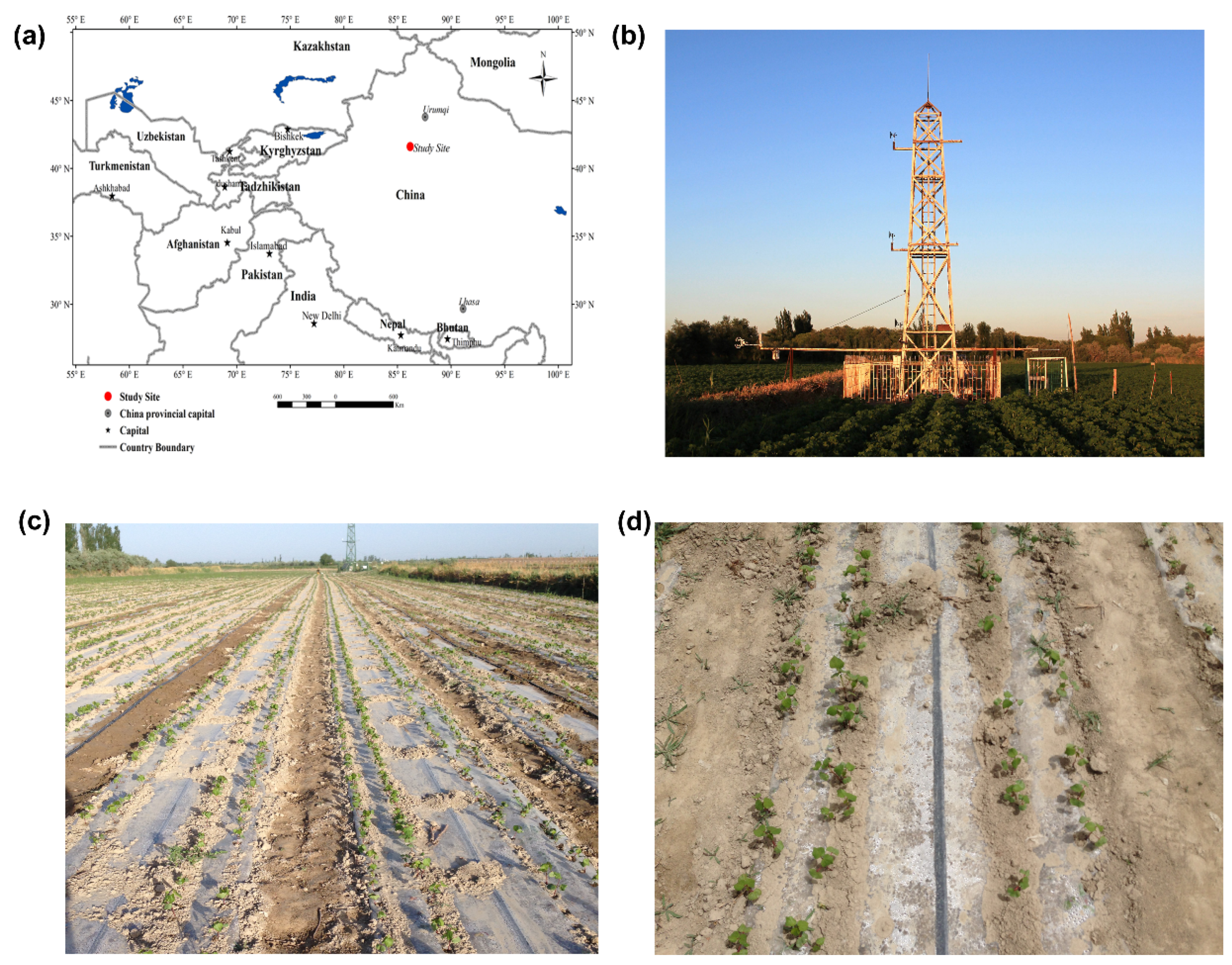
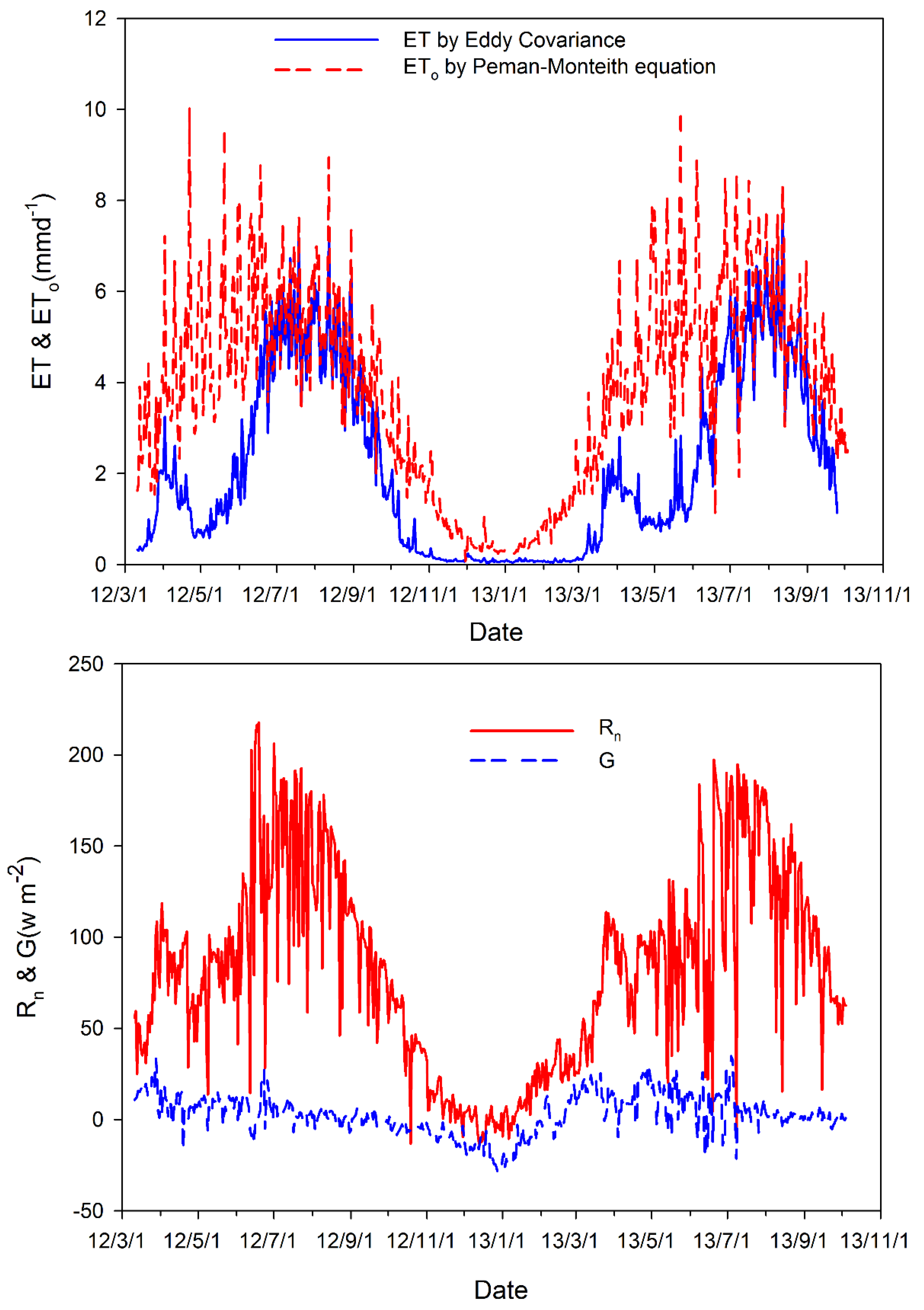

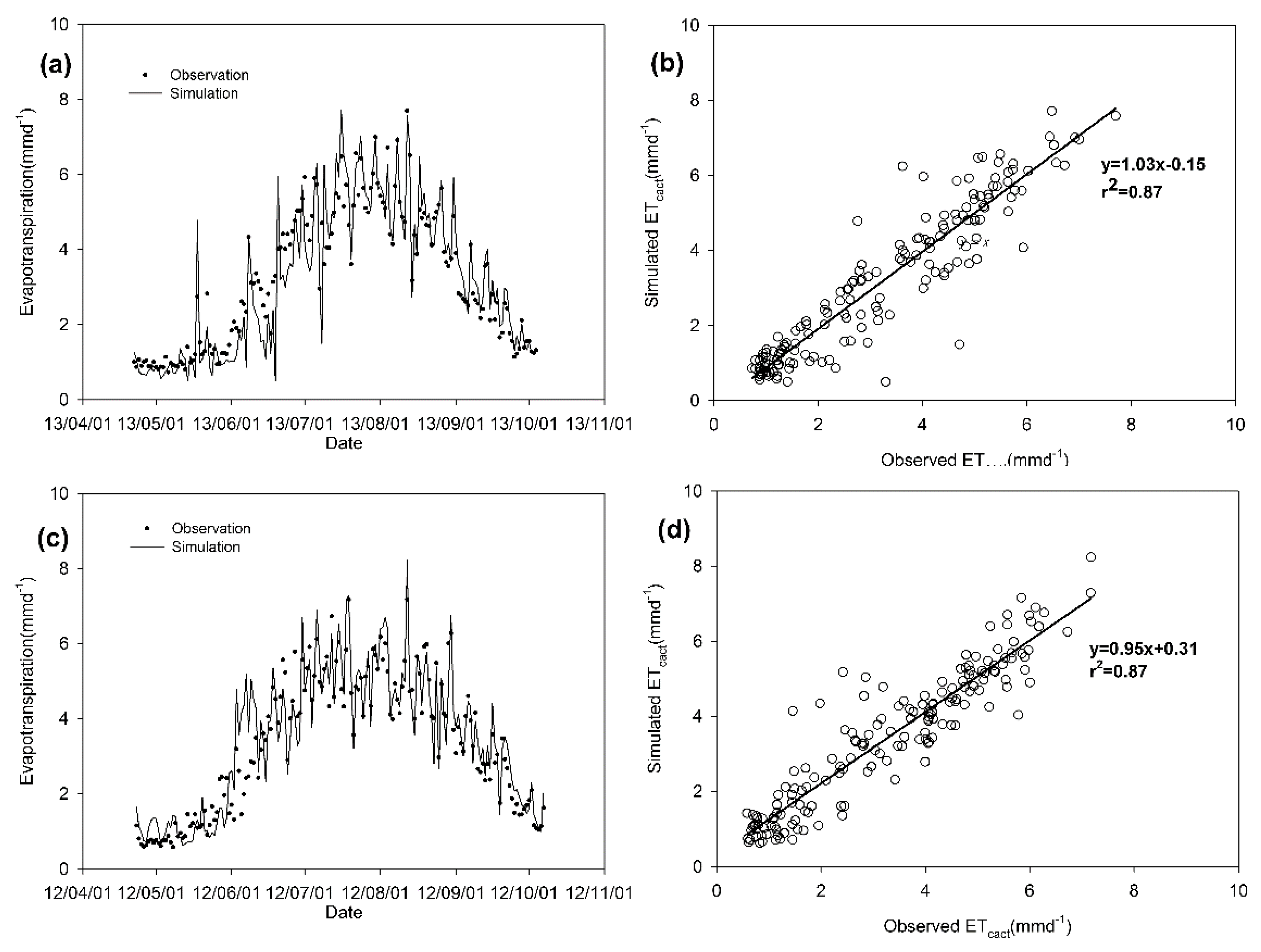
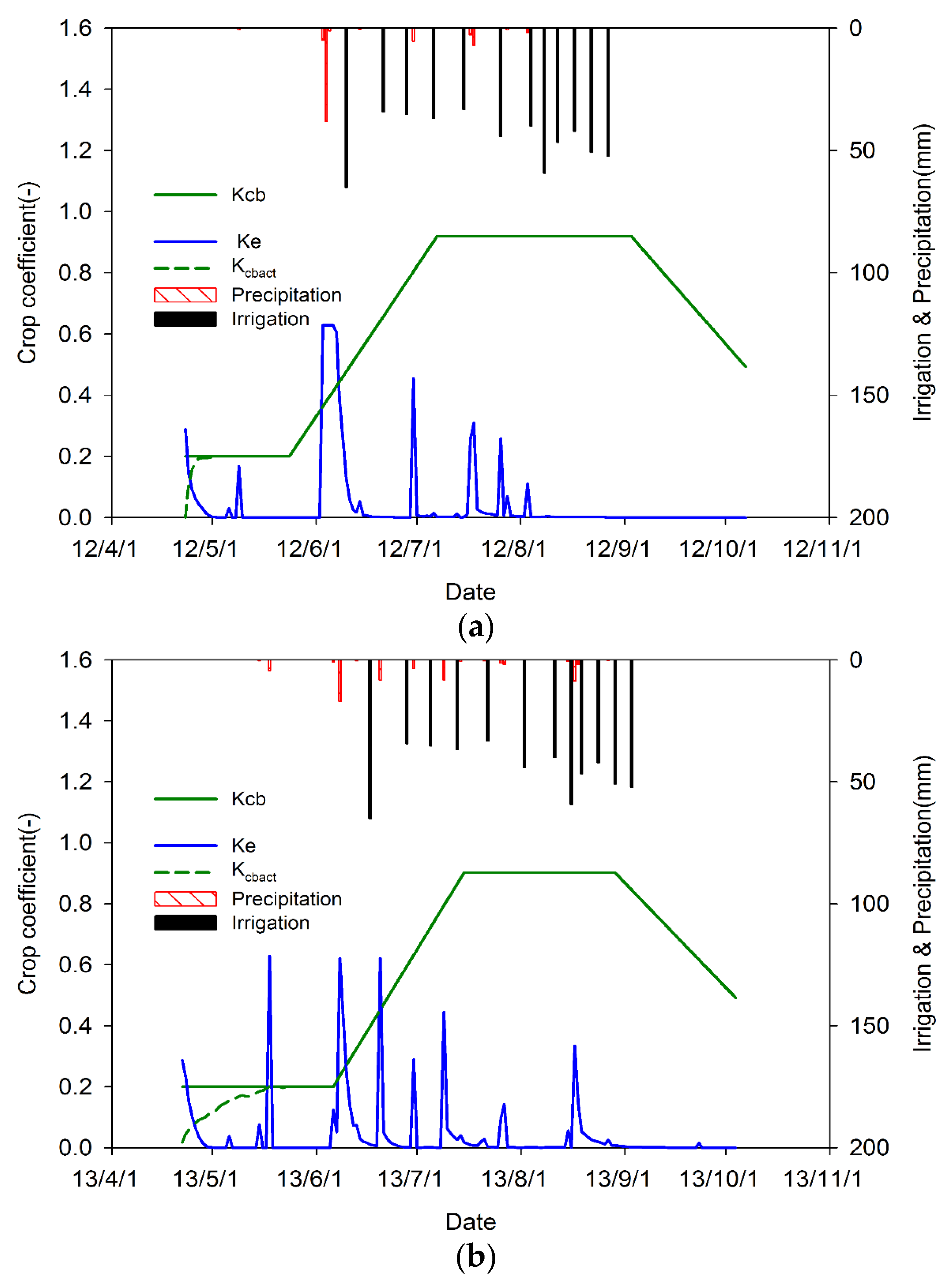

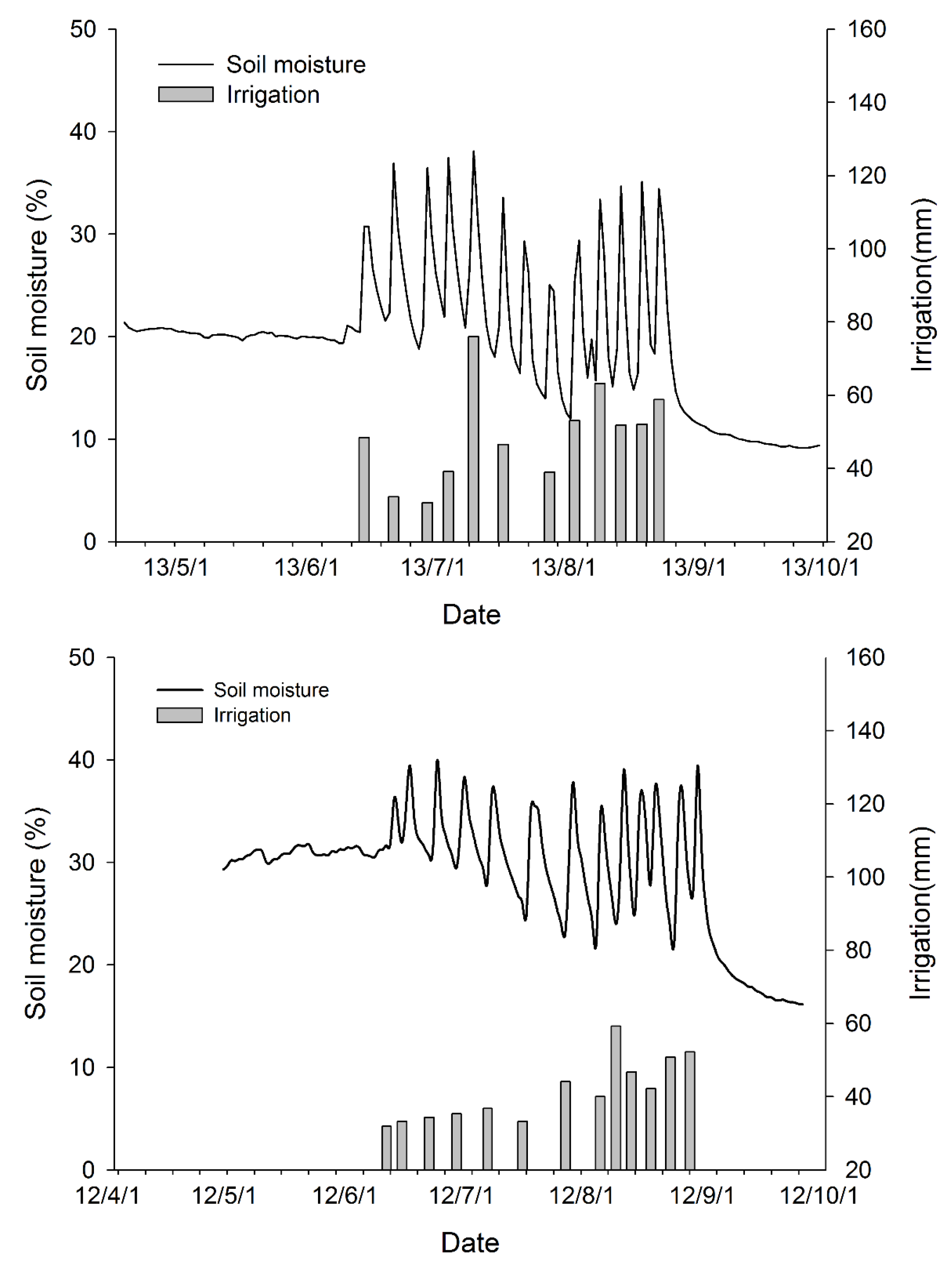

| Growth Stage | Squaring Stage | Flowering Stage | Bolls Stage | ||||||||||
|---|---|---|---|---|---|---|---|---|---|---|---|---|---|
| 2012 | Irrigation date | 6–10 & 6–14 * | 6–21 | 6–28 | 7–6 | 7–15 | 7–26 | 8–4 | 8–8 | 8–12 | 8–17 | 8–22 | 8–27 |
| Volume (mm) | 65.2 | 34.4 | 35.3 | 36.8 | 33.3 | 44.1 | 40.0 | 59.3 | 46.7 | 42.2 | 50.8 | 52.2 | |
| 2013 | Irrigation date | 6–13 | 6–20 | 6–28 | 7–3 | 7–9 | 7–16 | 7–27 | 8–2 | 8–8 | 8–13 | 8–18 | 8–22 |
| Volume (mm) | 48.5 | 32.3 | 30.7 | 39.2 | 76.0 | 46.5 | 39.0 | 53.1 | 63.2 | 51.8 | 52.1 | 58.8 | |
| Cotton Growth Stages | Phenological Growth Stages | 2012 | 2013 |
|---|---|---|---|
| Planting/initiation | Emergence & Squaring stage | 23 April–23 May | 22 April–5 June |
| Rapid growth | Squaring & Flower stage | 24 May–6 July | 6 June–14 July |
| Midseason | Flower & Boll stage | 7 July–2 September | 15 July–28 August |
| Maturity | Boll stage | 3 September–7 October | 29 August–4 October |
| Year | Physiological Parameter | Planting | Start Crop Development | Start Mid-Season | Start Late-Season | Harvest |
|---|---|---|---|---|---|---|
| 2012 | Root depth (m) | 0 | 0.4 | 0.70 | 0.70 | 0.70 |
| Crop height (m) | 0 | 0.20 | 0.76 | 0.76 | 0.76 | |
| Fraction of ground cover | 0 | 0.2 | 0.50 | 0.95 | 0.85 | |
| 2013 | Root depth (m) | 0 | 0.4 | 0.62 | 0.62 | 0.65 |
| Crop height (m) | 0 | 0.4 | 0.62 | 0.62 | 0.67 | |
| Fraction of ground cover | 0 | 0.20 | 0.50 | 0.95 | 0.85 |
| Parameter | Initial Values [12,34] | Calibrated |
|---|---|---|
| Crop coefficients | ||
| Kcb ini | 0.15 | 0.20 |
| Kcb mid | 1.15 | 0.90 |
| Kcb end | 0.50 | 0.50 |
| Depletion fraction | ||
| pini | 0.65 | 0.70 |
| pmid | 0.65 | 0.60 |
| pend | 0.65 | 0.60 |
| Soil evaporation | ||
| REW (mm) | 8 | 8 |
| TEW (mm) | 20 | 33 |
| Ze (cm) | 10 | 15 |
| Deep percolation | ||
| ap | 408 | 390 |
| bp | −0.0173 | −0.0173 |
| Capillary rise | ||
| a1 | 320.8 | 320.8 |
| a2 | 303.2 | 303.2 |
| a3 | −0.15 | −0.15 |
| a4 | 7.55 | 7.55 |
| b1 | −0.16 | −0.16 |
| b2 | −0.54 | −0.54 |
| b3 | 2.1 | 2.1 |
| b4 | −2.03 | −2.03 |
| Year | b * | r2 | RMSE | NSE | RSR | ARE | PBIAS | AAE |
|---|---|---|---|---|---|---|---|---|
| (mm·day−1) | (%) | (%) | (mm·day−1) | |||||
| 2012 (calibration) | 0.95 | 0.87 | 0.68 | 0.89 | 0.38 | 21.8 | 15.0 | 0.50 |
| 2013 (validation) | 1.03 | 0.87 | 0.72 | 0.84 | 0.40 | 18.1 | 15.4 | 0.50 |
| Growth Stages | Observation | 2012 | Observation | 2013 | ||||||||||||||
|---|---|---|---|---|---|---|---|---|---|---|---|---|---|---|---|---|---|---|
| Plastic Mulch | No Mulch | Plastic Mulch | No Mulch | |||||||||||||||
| ET * | ET | T | E | T/ET | ET | T | E | T/ET | ET | ET | T | E | T/ET | ET | T | E | T/ET | |
| Initial | 0.9 | 1.0 | 0.9 | 0.1 | 88.3 | 1.1 | 0.9 | 0.2 | 78.4 | 1.3 | 1.1 | 0.9 | 0.2 | 81.8 | 1.2 | 0.9 | 0.3 | 76.1 |
| Crop development | 3.5 | 3.5 | 3.2 | 0.3 | 90.3 | 4.9 | 3.2 | 1.8 | 64.3 | 4.0 | 3.6 | 3.1 | 0.5 | 87.0 | 5.3 | 3.1 | 2.2 | 58.4 |
| Mid-season | 5.0 | 5.1 | 5.0 | 0.1 | 98.3 | 6.2 | 4.9 | 1.2 | 80.0 | 5.2 | 5.4 | 5.3 | 0.1 | 97.5 | 6.8 | 5.3 | 1.5 | 78.2 |
| Late season | 2.5 | 2.7 | 2.7 | 0.0 | 100.0 | 2.8 | 2.6 | 0.2 | 93.4 | 2.4 | 2.7 | 2.6 | 0.0 | 99.6 | 2.7 | 2.5 | 0.2 | 94.2 |
| Full crop season | 3.3 | 3.4 | 3.3 | 0.1 | 95.9 | 4.2 | 3.3 | 1.0 | 77.0 | 3.2 | 3.2 | 3.0 | 0.2 | 93.6 | 4.0 | 3.0 | 1.0 | 74.1 |
© 2016 by the authors; licensee MDPI, Basel, Switzerland. This article is an open access article distributed under the terms and conditions of the Creative Commons by Attribution (CC-BY) license (http://creativecommons.org/licenses/by/4.0/).
Share and Cite
Tian, F.; Yang, P.; Hu, H.; Dai, C. Partitioning of Cotton Field Evapotranspiration under Mulched Drip Irrigation Based on a Dual Crop Coefficient Model. Water 2016, 8, 72. https://doi.org/10.3390/w8030072
Tian F, Yang P, Hu H, Dai C. Partitioning of Cotton Field Evapotranspiration under Mulched Drip Irrigation Based on a Dual Crop Coefficient Model. Water. 2016; 8(3):72. https://doi.org/10.3390/w8030072
Chicago/Turabian StyleTian, Fuqiang, Pengju Yang, Hongchang Hu, and Chao Dai. 2016. "Partitioning of Cotton Field Evapotranspiration under Mulched Drip Irrigation Based on a Dual Crop Coefficient Model" Water 8, no. 3: 72. https://doi.org/10.3390/w8030072





